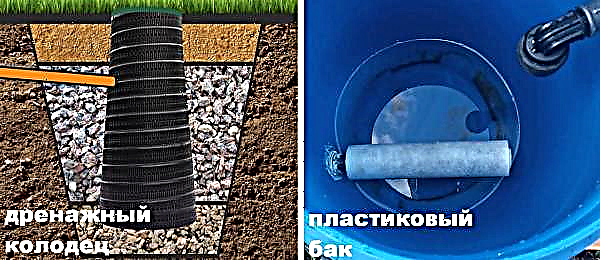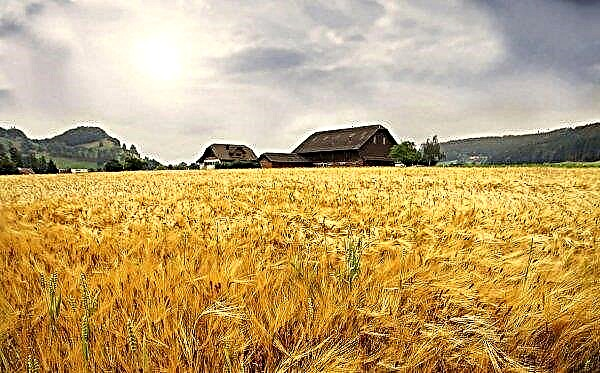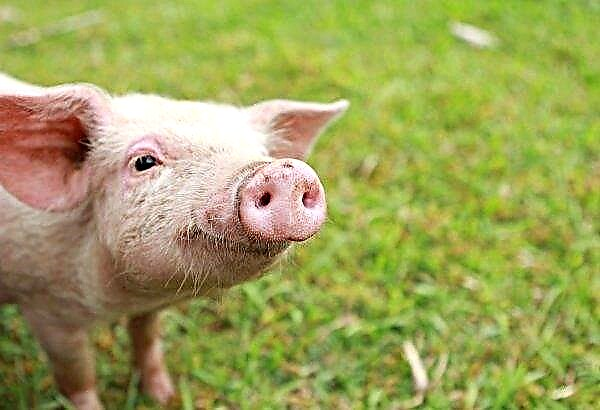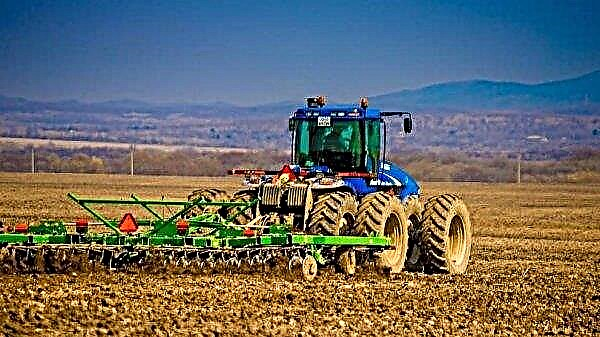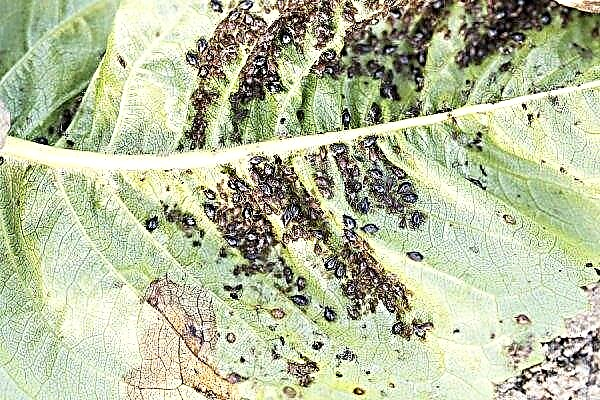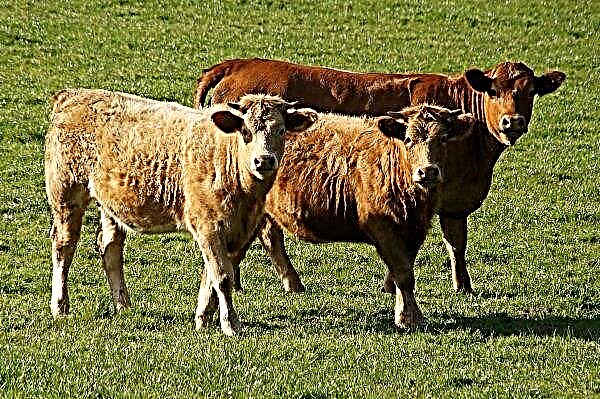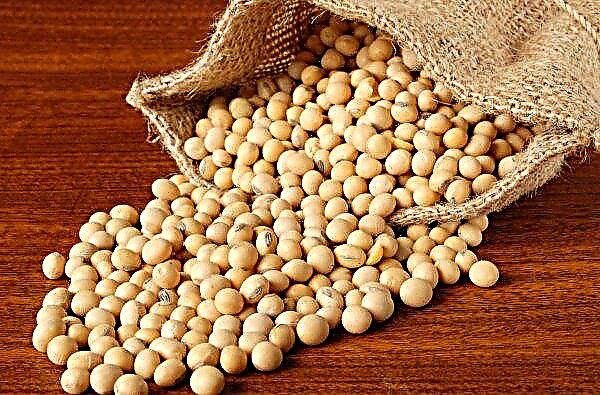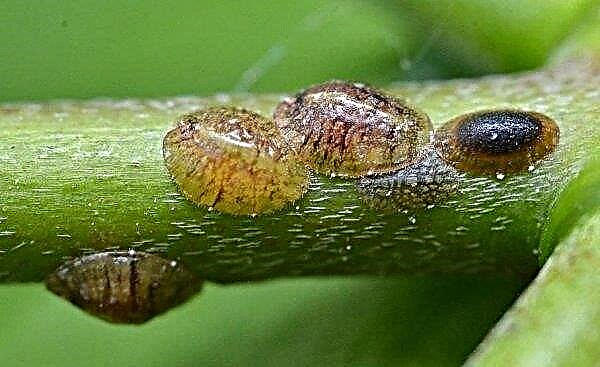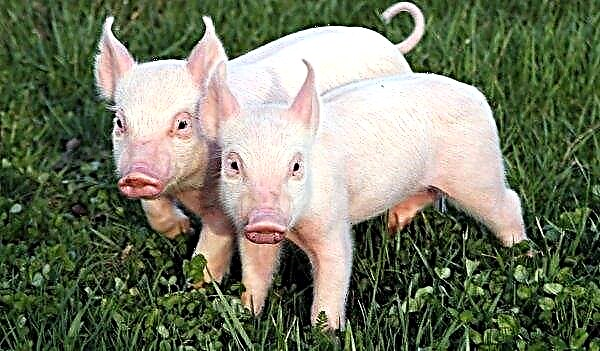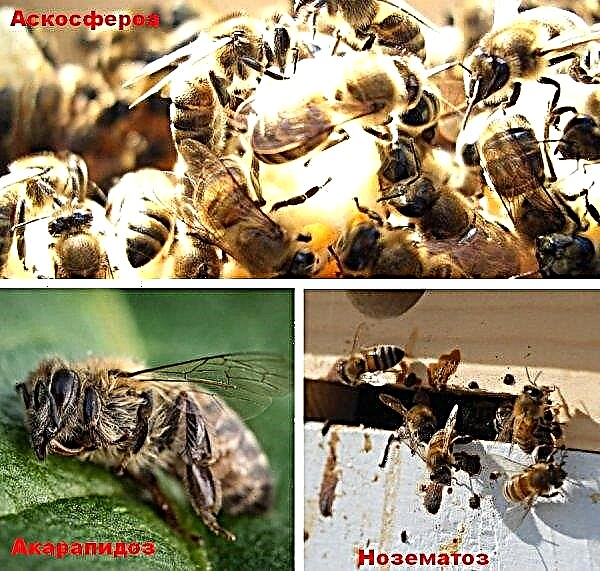Klusha tomatoes were bred relatively recently in Russia. Tasty and large tomatoes appealed to many, so the variety quickly became popular in all regions of the country. Consider a detailed description of Klusha tomatoes, especially their sowing and cultivation, as well as some recommendations for the care and prevention of possible problems.
Grade description
The name of the variety comes from the appearance of the bushes: they are slightly reminiscent of a brood hen that hides the wings of their chicks - the fruits are securely hidden under dense green foliage.
Did you know? Tomatoes began to grow the Indians of South America about 9 thousand years ago.
Consider a detailed description of the features of Klush tomatoes:
- The plant is standard, its height does not exceed 50 cm.
- On open ground, you can plant up to 8 bushes per 1 square. m
- The stem is thick and strong, able to withstand the weight of the fruit.
- The foliage is dense, but it is not necessary to prune it for high yields.
- The leaves are dark green in size.
- Green tomatoes are completely hidden under the foliage, but begin to peek because of it as they mature.
- On one cluster, 6–8 flowers are formed, 95% of which are then transformed into ovaries.
- The first portion of ripe tomatoes can be harvested already on the 97th day after sowing the seeds.
- Tomatoes have a rounded shape, slightly flattened above and below.
- Unripe fruits have a light green hue, and the color of ripe tomatoes is bright red. The inner part consists of 7 seed chambers.
- The weight of the fruit depends on the method of cultivation and is 100-150 g. Whole clusters of tomatoes are placed on the branches of the bush.
- From one plant, you can harvest 1.8–2.4 kg of fruits.
- Tomatoes have a great taste and have a dense flesh, retain their presentation after transportation.
- The peel of tomatoes is dense, does not crack during heat treatment.
Photo gallery
A variety of this variety are Super Klusha tomatoes. The ripe fruits of this subspecies are bright pink. The number of tomatoes on the bush in the variety "Super Klusha" is greater compared to the variety "Klusha".
Advantages and disadvantages
- Klush tomatoes have several advantages, thanks to which many gardeners choose them for cultivation. The main advantages of these tomatoes are:
- high productivity;
- compactness of the plant;
- fast ripening;
- tasty fruits;
- lack of required cropping;
- the possibility of using raw and canned;
- well preserve the presentation in storage and transportation;
- endurance in different climatic conditions;
- resistance to many diseases.
Important! To get a good tomato crop, you need to carefully follow all the recommendations for caring for tomato bushes.
- Tomatoes of this variety also have disadvantages, although they are much smaller in comparison with the advantages. The minuses of Klush tomatoes include:
- tendency to certain diseases (late blight, fungal diseases);
- many leaves on the bush.
Sowing seeds for seedlings
The preparation process for sowing seeds of Klusha tomatoes is almost no different from the usual sowing of other varieties. It is necessary to properly prepare the soil and the seeds themselves, then sow them in the container selected for seedlings. When the seeds sprout, you need to follow the recommendations for caring for them in order to plant them at the right time in a greenhouse or on open ground. Consider the details of sowing seeds of this variety for seedlings.
Consider the details of sowing seeds of this variety for seedlings.
Optimal timing
It is recommended to start growing Klusha tomato seedlings in mid-March. The resulting sprouts can later be planted in open beds or in a greenhouse. The sequence of actions for both cases is the same.
The timing of planting grown tomato seedlings in a greenhouse is the first decade of May. The time of planting sprouts on open ground is determined by the height of the seedlings. As soon as it reaches 20 cm, the plants are prepared for transplantation into open soil.
Soil mix
The soil for growing Klusha tomato seedlings should be fertile and fairly loose, with an acidity of 4.5. You can buy special soil at the store or use a mixture of river sand and small peat chips in a 1: 1 ratio. Before sowing, you need to thoroughly calcine such soil in the oven. But most often, for growing seedlings, the gardener takes the land from his own plot. Such soil must first be decontaminated. This procedure is carried out using a finished substrate, which is sold in specialized stores. Following the instructions written on the packaging, prepare a liquid solution, which is impregnated with the soil taken for seedlings.
But most often, for growing seedlings, the gardener takes the land from his own plot. Such soil must first be decontaminated. This procedure is carried out using a finished substrate, which is sold in specialized stores. Following the instructions written on the packaging, prepare a liquid solution, which is impregnated with the soil taken for seedlings.
Disinfecting the soil mixture can be carried out using potassium permanganate. For 2 liters of pure water you will need 1 g of potassium permanganate. The resulting solution is carefully impregnated with soil. For even greater effectiveness, the soil disinfected in this way is also calcined in the oven.
Did you know? From a botanical point of view, a tomato belongs to berries, but in everyday life it is more often called a vegetable. And by order of the European Union, made in 2001, in the Old World, tomatoes are classified as fruits.
Container for growing
You can sow the seeds of this variety in plastic or wooden boxes. Sometimes they use small medium-sized plastic cups to grow each sprout separately. For seedlings you need to make a good drainage. In containers for growing seedlings, it is necessary to make holes in the bottom for draining excess water. Planted seeds need moderate watering - if there is an excess of moisture, they will not germinate.
For seedlings you need to make a good drainage. In containers for growing seedlings, it is necessary to make holes in the bottom for draining excess water. Planted seeds need moderate watering - if there is an excess of moisture, they will not germinate.
Seed preparation
The quantity and quality of seedlings will depend on the proper preparation of planting material. Therefore, seed preparation can be divided into several stages.
- Quality checking. To do this, tomato seeds are dipped in salt water. Poor planting material, which will not germinate, will float to the surface of the saline solution, and seeds with good germination will sink to the bottom of the glass.
- Disinfection. For this, planting material is soaked in a solution of potassium permanganate for 1 hour, and then placed in a solution of a growth accelerator for 24 hours.

- Germination. Prepared seeds are laid on wet gauze and kept in it for a couple of days. Gauze should be periodically sprayed with water, but you can not make the fabric too wet.
Sowing seeds
Klusha tomato seeds are planted in containers with prepared soil. In the soil make a small hole 1 cm deep into which the seeds are lowered. Burying them too deep is not recommended, as it will be very difficult for the seeds to germinate through a thick layer of soil.
Important! The distance between adjacent holes should be at least 2 cm so that the sprouts are not crowded.
Tomato seeds should be sprinkled with loose earth and watered with a small amount of settled warm water.
Seedling Care
For the successful cultivation of tomato seedlings, you need to follow several important rules that relate to temperature conditions, lighting and general care for sown seeds. Consider the main recommendations.
- Cover the container with tomato seeds with a film.
- To germinate the seeds, put the future seedlings in a dark and warm place for 1 week.
- After the shoots appear, you can remove the film, and move the container to a well-lit place. Keep them at 24 ° C.
- After the first 4 leaves are formed on the sprouts, the bushes are planted in any small containers. Peat cups will do.
- Sprouts are irrigated as the soil dries. Do not fill the seedlings with large amounts of water.
- Containers with plants put in a shaded place for a couple of days. This will allow the sprouts to take root and securely gain a foothold in the soil.
- When the sprouts are rooted, the box with seedlings is again placed in a sunny place.
- For better growth, you need to feed the seedlings with nitrogen-containing fertilizers. Before planting in the ground, it is recommended to do this twice. You can not use manure for feeding. It contains harmful microorganisms that cause diseases of seedlings.
- Seedlings are ready for transplanting to a permanent place after the height of the plants has reached 20 cm.
Video: Caring for tomato seedlings
Seedling hardening
In order for Klusha tomato sprouts to better survive planting in the open ground, it is recommended to harden them. This will help the plants to get used to the growth conditions outdoors.
Did you know? The weight of ripe wild tomatoes that still grow in South America is only 1 g.
Hardening of tomato seedlings should begin 14 days before the planned transplantation into the open ground. Tanks with sprouts need to be kept for several days at a temperature of about 12 ° C. After that, they need to be moved outside and left there for about an hour. The time spent seedlings in the open air is gradually increasing every day.
Planting seedlings in a permanent place
Tomato seedlings are transplanted on open ground or in a greenhouse at the age of 2 months. At this time, the sprouts usually have about 7 leaves, and the height of the stems is about 20 cm. The outdoor temperature during transplantation should be at least 25 ° C.
Consider a detailed algorithm for planting sprouts:
- Fertilize in the dug up soil on which tomato bushes will grow. You can use humus, sawdust or ash.
- To disinfect the soil, pouring it with boiling water or a solution of potassium permanganate.
- Dig small holes in the soil. The optimal layout for their placement is staggered. The distance between the wells should be at least 40 cm.
- Pour half a bucket of warm water into each dug hole.
- Remove the tomato seedlings from the container together with an earthen lump located around the roots and place them in the prepared holes.
- Sprinkle sprouts with earth and pour warm water on them again.
 For planting Klusha tomato seedlings in a greenhouse, the sequence of actions is similar. The humidity level in the greenhouse should be around 60%.
For planting Klusha tomato seedlings in a greenhouse, the sequence of actions is similar. The humidity level in the greenhouse should be around 60%.Important! In a greenhouse on an area of 1 square. m should be placed no more than 5 bushes of tomatoes.
Do not keep seedlings in containers for too long. If you delay the planting of tomatoes in open ground, then the seedlings will carry it much more difficult and may even die. Transplanting Klusha tomatoes into the ground is best in late May or early June. And when growing tomatoes in a greenhouse, a transplant can be done a week earlier.
How to care
To seedlings took root in the open ground, you need to carry out proper care for them. It includes timely watering and fertilizing the soil, as well as pruning leaves, tying stems and maintenance work to prevent diseases and protect against possible pests.
Watering
During the period of growth, flowering and the formation of ovaries, Klush tomato bushes need a large amount of water. It is recommended to water them when the soil around the stem becomes dry, but not less than 1 time in 4 days. General recommendations for watering plants are:
General recommendations for watering plants are:
- water should be at room temperature;
- pour water with a spray jet very carefully and only to the root so as not to wet the leaves and prevent burns;
- watering should be done only in the evening, when the sun has almost dropped below the horizon.
Top dressing
To ensure the rapid growth of the tomato bush and increase productivity, mineral fertilizers should be applied to the soil. The most common types of dressing for Klush tomatoes are listed below:
- ready-made fertilizer in store;
- yeast;
- organic fertilizers;
- ash;
- iodine;
- boric acid;
- ammonia;
- hydrogen peroxide.
Video: Fertilizing Tomatoes for High Yields
The feeding procedure is as follows:
- 2 weeks after transplanting, tomato bushes are watered with solutions of phosphorus and potassium fertilizers, which stimulate plant growth. On 1 bush leaves 1 liter of solution.
- 3 weeks after the first top dressing, fertilizers are applied repeatedly, increasing the amount of solution by 2 times.
Stepson
Bushes of Klusha tomatoes have many leaves that completely cover the fruits. Until ripening, tomato growth occurs in the middle of the bush. But this does not have a bad effect on tomato yield.  The plant is genetically limited in growth and forced to grow in width. Therefore, you can not cut the leaves on the bush "Klushi", with the exception of those located below the first flower brush. They interfere with watering the plant and lead to stagnation of air near the roots, which can cause serious diseases of tomatoes.
The plant is genetically limited in growth and forced to grow in width. Therefore, you can not cut the leaves on the bush "Klushi", with the exception of those located below the first flower brush. They interfere with watering the plant and lead to stagnation of air near the roots, which can cause serious diseases of tomatoes.
Important! For one pinching, you can not cut more than 2-3 leaves so as not to damage the plant too much.
It is necessary to conduct stepsoning approximately 1 time per week. 24 hours after the procedure, the tomato bush should be well watered to stimulate its further growth.
Soil care
So that young tomato bushes grow well and gain strength for flowering, you need to properly care for the soil around the plants.  Mulching tomatoes protects the earth from drying out and weeds. To do this, it is enough to carry out the following steps:
Mulching tomatoes protects the earth from drying out and weeds. To do this, it is enough to carry out the following steps:
- Remove all weeds around tomato bushes. Extraneous vegetation not only sucks moisture out of the ground, but also obscures the tomatoes from the sun, which adversely affects the growth of plants.
- Periodically loosen the soil around the bushes. The loose earth better allows oxygen and water to pass through during irrigation, and this favorably affects the growth of the root system.
- Mulching protects the soil around the tomatoes from drying out and weed growth, and keeps the soil loose. As a mulch, it is better to use organic materials, which gradually decompose upon contact with the top soil layer and form a layer of nutrient humus around. Organic mulch includes straw, peat, compost, wood bark or sawdust, needles and yellowed foliage.
Did you know? The largest tomato was grown in Wisconsin (USA). The weight of the fetus was almost 3 kg.
Bush tying
Bushes of Klusha tomatoes have a sturdy stalk that can withstand the weight of a large number of fruits. Therefore, carrying out garter bushes is not required. But in some cases, the stem may need support due to the large number of side branches and a lot of tomatoes. In this case, it is enough to put 2-3 thin sticks around the bush, which will maintain its integrity so that the stems do not fall apart and do not lie on the ground.
Preventative treatment
Klusha tomatoes are prone to some common diseases and may be attacked by pests. In order to get a good crop and protect the plants, you need to carry out their regular preventive treatment.
Information on possible diseases and pests of Klusha tomatoes is presented below.
- Late blight. It is characterized by the appearance of large brown spots on tomatoes and the decay of the stem and leaves of the plant. The diseased tomato bush needs to be dug up and burned. To prevent this disease, plants need to be treated with Rodomil 4 times per season.
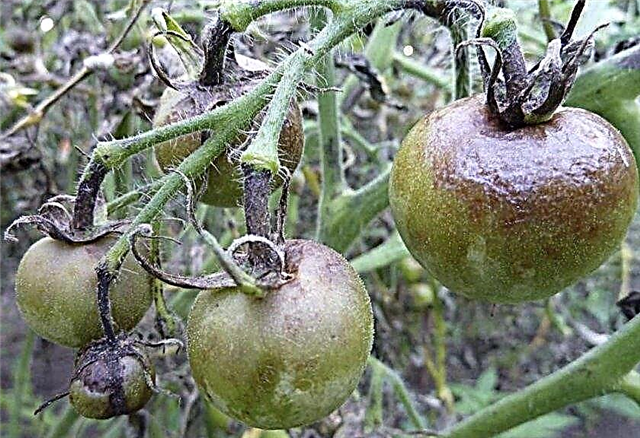
- Gray rot. Often occurs on bushes of tomatoes grown in greenhouses. The reason may be too acidic soil and insufficient airing. A symptom of the disease is the appearance on the plant stem of plots with a gray coating.For treatment, copper sulfate is used, which treats the affected areas of the stem. Prevention consists in regular ventilation and the addition of bone meal or ash to the soil, which improves the acidity of the soil.
- Vertex rot (strick). It appears dark spots on tomatoes. The reason may be high humidity or improper watering of plants. Tomato bushes need to be treated with a 0.4% solution of potassium chloride. For the prevention of the disease, it is necessary to ensure free air circulation near the root system of the plant. This can be done by trimming the lower leaves.
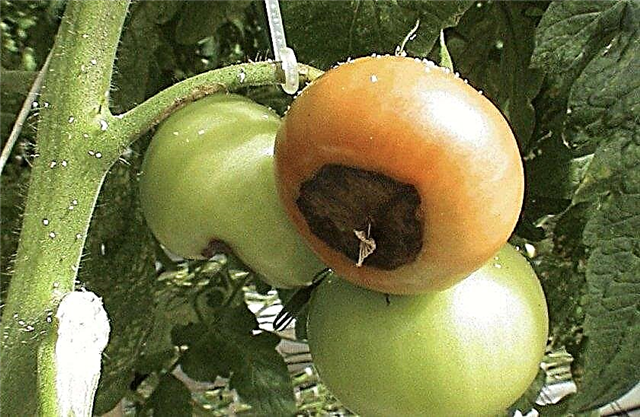
- Streptozitis. It belongs to the category of fungal diseases and is characterized by the appearance on the stem and leaves of large white spots with a dark outline. To combat this disease, tomato bushes are treated with copper chloride. The interval between treatments is about 2 weeks.
- Pests (spider mite, Colorado potato beetle, bear and whitefly). They can eat the leaves of the bush, causing its death, or undermine the root system. The spider mite harms the leaves of the plant, drinking all the juices from them, as a result of which the bush dries up. Preventive actions against this problem consist in the regular processing of tomato bushes with black pepper solution or with ready-made insect repellents, which can be bought in specialized stores. Along the perimeter of beds with Klush tomatoes, you can plant fragrant herbs that will deter pests.
 Spider mite on tomatoes
Spider mite on tomatoes




 Spider mite on tomatoes
Spider mite on tomatoes